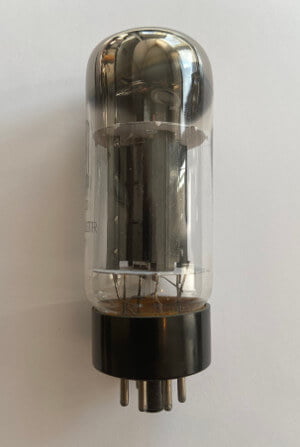Table of Contents
Amplifiers that use 6L6 tubes are high-voltage appliances. They can be dangerous if you are not experienced working on them. If you are not sure, it is always best to take it to an experienced technician. Proceed at your own risk as this can be dangerous!
The bias point for 6L6GC tubes depends on the plate voltage that the amplifier is designed to use. Most amps using this tube run between 430-450 volts DC. The 6L6 bias point at 60% dissipation for an amp designed to use 450 volts is: 30/450 x .6 = .04 or 40mA.
This is based on the fact that the 6L6GC is a 30-watt tube, and we are aiming to run it at 60% of its maximum dissipation.
Bias Summary
- For biasing a 6L6, a common formula is to divide the plate voltage by the maximum plate dissipation of the tube, which is usually around 30 watts for a 6L6GC. For example, if the plate voltage is 438 volts, the bias point would be around 68mA.
- The bias point should not exceed 70% dissipation, as this would be pushing the tube too hard.
- The 6L6GC is a 30 watt tube, and even with a very high plate voltage, biasing on the cold side is recommended. Biasing a little hotter may be tried to see if it improves the tone, but it should not exceed the maximum plate dissipation.
- The bias range for a 6L6 tube is typically between 20mA and 60mA.
6L6GC Bias Point By Voltage
If you have a class AB amplifier that uses fixed bias and requires the setting to be changed with every tube change, this chart can help you. This is for a 6L6GC tube type with some common amp voltages and safe dissipation settings. All readings are mA.
| Plate Voltage | 50% | 60% | 70% |
| 460 | 32.6 | 39.1 | 45.7 |
| 450 | 33.3 | 40 | 46.7 |
| 440 | 34.1 | 40.9 | 47.7 |
| 430 | 34.9 | 41.9 | 48.8 |
Ideal 6L6GC Bias Point
The ideal bias point will result in the tubes operating in their most linear range. This means that they will produce the least amount of distortion. This is because the tube does not hit saturation or cut off and can amplify an input signal in its entirety.
It depends on your amp and preferences. But you may want to adjust the bias to be anywhere from slightly below to above the ideal point.
60% dissipation is usually a good point of reference for class AB. The setting offers quality sound, longevity as well as performance.
In class A, 80% is recommended and is pretty much the average. For cathode-biased amps, they take care of the adjustment themselves. Unless you are designing an amp. In this case, the setting is 95%.
Just be sure to stay within the maximum ratings. And always use a meter to measure the bias point so that you don’t cause any damage to your tubes.
Learn more about the 5881 vs 6L6 here!

Other 6L6 Tube Bias Ranges
While we have been touching on the 6L6GC, which is rated for 30 watts, other models are lower.
The 6L6, 6L6G, and 6L6GB, are rated at 19 watts and so the bias setting will be different. The equation for this is watts/plate voltage x dissipation. For example, if the amp was designed to use a 450 plate voltage. Then a 60% dissipation would need a bias setting of .025mA.
The 6L6WGB, and 6L6WGC are rated at 26 watts. And so this must be taken into consideration when calculating the bias setting. An example of this with a 450 plate voltage would be a bias setting of .034mA. Again, this is using a dissipation of 60%.
Learn more about 6L6 vs El34 tubes here.
FAQs
Do you need to bias 6L6 tubes?
Yes, if you are using an amplifier designed with a class A or AB power section, then you may need to bias your tubes. If it uses a fixed bias system, then the tubes will need to be biased with every change.
If your amplifier is cathode biased, then it will take care of the setting itself. Always consult your owner’s manual to see what s required when changing 6L6 tubes.
How do you bias 6L6 tubes?
6L6 tubes are biased using an adjustment potentiometer located somewhere on the amplifier. A meter is needed to read the bias setting, and it is adjusted using the pot.
Some amplifier manufacturers offer bias jacks on the outside so that the unit does not need to be opened up.
Some amplifiers do not offer a means of adjustment. Brand-specific tubes must be purchased that are already tested for their current draw.

